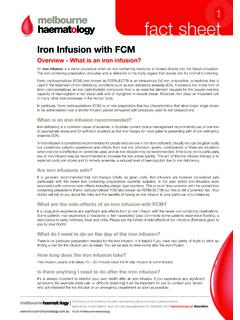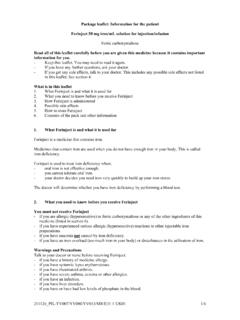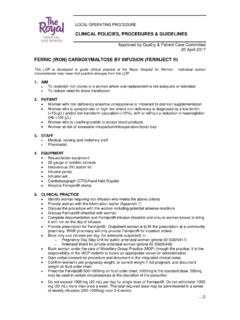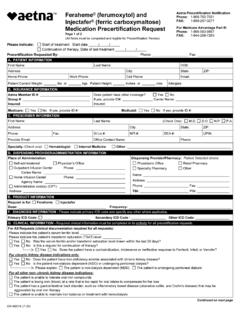Transcription of NEW ZEALAND DATA SHEET 1 PRODUCT NAME 2 ... - Medsafe
1 FERINJECT Page 1/13 PRODUCT Information NZ E10 NEW ZEALAND DATA SHEET NAME OF THE MEDICINE FERINJECT ferric carboxymaltose Chemical structure The active substance of FERINJECT is a complex of polynuclear iron (III)-hydroxide with 4(R)-(poly-(1 4)-O- -D-glucopyranosyl)-oxy-2(R),3(S),5(R),6- tetrahydroxy-hexanoate. The relative molecular weight is approximately 150,000 Da, corresponding to the empirical formula: [FeOx(OH)y(H2O)z]n [ (C6H10O5)m (C6H12O7) l]k, where n 103, m 8, l 11, and k 4. CAS-Number 1461680-64-7 DESCRIPTION Solution for intravenous use. FERINJECT is a dark brown, non-transparent, colloidal solution. Excipients Sodium hydroxide (for pH adjustment) Hydrochloric acid (for pH adjustment) Water for injections PHARMACOLOGY Pharmacodynamic properties ferric carboxymaltose (FCM) solution for injection/ infusion contains iron in a stable ferric state as a complex with a carbohydrate polymer designed to provide iron for the iron transport and storage proteins in the body (transferrin and ferritin).
2 FCM was effective in increasing haemoglobin (Hb) and serum ferritin concentrations in patients with mild to moderate iron -deficiency anaemia. The intravenous (IV) iron dose was 500 mg weekly for up to 4 weeks (n=20) or 1,000 mg weekly for up to 2 weeks (n=26). With the 500 mg iron dose, 37% of patients achieved normal Hb levels within 8 weeks and 75% achieved a 20 g/L increase in Hb on at least one occasion. With 1,000 mg iron , 48% of patients achieved normal Hb levels within 6 weeks and 73% achieved a 20 g/L increase in Hb on at least one occasion. The target serum ferritin concentration 100-500 g/L was reached with both doses and remained within the target range at 2 weeks follow-up (at 6 and 4 weeks respectively for the two dose groups)-data were only available for about half the 500 mg iron dose group.
3 FERINJECT Page 2/13 PRODUCT Information NZ E10 Pharmacokinetic properties After a single 100 mg IV iron dose of FCM solution (n=6) injected over 1 min, serum iron concentration peaked at a mean of 15 min. After 500, 800 or 1,000 mg iron in 250 mL normal saline infused over 15 min (n=6 for each dose), serum iron concentration peaked at means of 20 min, 1 h and h, respectively. The mean volume of distribution was approximately 3 L, corresponding to the plasma volume. Mean plasma clearance ranged from mL/min and terminal half life from 7-12 h. Renal elimination was negligible. Within 8 h of a single radiolabelled 100 mg IV iron dose of FCM to patients with iron deficiency or renal anaemia, most of the radiolabelled iron had cleared the circulation and distributed to the bone marrow, liver and spleen.
4 Within 6-9 days, the radiolabelled iron was incorporated into the red blood cells. After 24 days, iron utilisation was 91-99% in iron deficiency anaemia and 61-84% in renal anaemia. CLINICAL TRIALS Clinical studies showed that the haematological response and the filling of the iron stores was faster after intravenous administration of FCM than with orally administered comparators. The phase III studies undertaken with FCM included patients with iron deficiency (ID) of different aetiologies, associated with non-dialysis and dialysis dependent chronic kidney disease (CKD), inflammatory bowel disease, heavy menstrual bleeding, post-partum iron deficiency anaemia (IDA), or patients with chronic heart failure and iron deficiency. IDA associated with haemodialysis-dependent chronic kidney disease.
5 The efficacy and safety of FCM compared to Venofer ( iron sucrose, intravenous) for the treatment of IDA secondary to chronic renal failure was assessed in a multi-centre, open-label, randomised, parallel-group, Phase III study in 237 patients on haemodialysis or haemodiafiltration. IDA was defined as Hb 115 g/L in addition to transferrin saturation (TSAT) <20% and/or serum ferritin <200 g/L. Patients received 200 mg iron 2 or 3 times weekly (depending on the timing of dialysis sessions) until their individual calculated cumulative dose had been reached. The mean duration of treatment was days (range 1 to 27) and days (range 1 to 43 days) for the FCM and Venofer groups, respectively. Patients treated with erythropoietin (EPO) should have had received this treatment for at least 8 weeks prior to inclusion in the study and increases in the dose of EPO were not permitted.
6 The primary efficacy endpoint was defined as the percentage of patients reaching an increase in Hb of 10 g/L at 4 weeks. The percentage of responders was (52/118) in the FCM group and (41/116) in the Venofer group; the difference between groups was not statistically significant (chi2 = ). At follow-up 4 weeks after the final dose of medication, secondary efficacy parameters (Hb 110-120 g/L, serum ferritin 200-800 g/L, TSAT 20-50%) demonstrated successful increase in iron stores for both treatment groups. IDA associated with non-dialysis-dependent chronic kidney disease. A multi-centre, randomised, open-label, controlled, 8-week, Phase III study in 255 patients was conducted to compare the safety and efficacy of intravenous infusions of the FCM solution with oral administration of ferrous sulphate, independent of Hb response to EPO, FERINJECT Page 3/13 PRODUCT Information NZ E10 in treating IDA in non-dialysis-dependent chronic kidney disease (ND-CKD).
7 IDA was defined as Hb 110 g/L, TSAT 25%, and serum ferritin 300 g/L. Patients treated with EPO should have had received this treatment for at least 8 weeks prior to inclusion in the study and increases in the dose of EPO were not permitted. Patients randomised to FCM treatment received 1 to 3 doses of FCM solution intravenously at 2-4 week intervals: 15 mg iron /kg for weight 66 kg to a maximum of 1,000 mg iron for the initial dose and a maximum of 500 mg iron for subsequent doses. Patients randomised to oral iron treatment received ferrous sulphate tablets (65 mg iron ) 3 times daily for 8 weeks. In a modified intent-to-treat analysis which excluded 8 FCM patients and 2 ferrous sulfate patients, the primary efficacy endpoint, defined as the percentage of patients with an increase in Hb 10 g/L at any time between baseline and end of study, or time of intervention, was reached by (87/144) of FCM-treated patients compared to (35/101) of oral iron -treated patients (p< ; 95% confidence interval (CI) , ).
8 The modified intent-to-treat population comprised patients with at least one dose of study medication, stable erythropoietin dose, at least one post-baseline Hb assessment and GFR 45 mL/ m2. FCM was also demonstrated to be superior to oral iron across all secondary ranked efficacy endpoints: Hb change 10 g/L and a serum ferritin change 160 g/L at any time during the study ( versus , respectively; p< ; 95% CI , ) or a Hb change 10 g/L before Day 42 ( versus , respectively; p< ; 95% CI , ). In a 44-week extension to this study, the efficacy of FCM in the long-term maintenance treatment of anaemia in ND-CKD was evaluated in 140 patients. Clinical success (Hb 110 g/L, serum ferritin 100-800 g/L, TSAT 30-50%) was achieved in (72/140) of patients, with 10% (14/140) exhibiting sustained clinical success at 50% or more of the assessments.
9 In the ND-CKD subgroup of another study, the safety and efficacy of IV injection of FCM solution, 15 mg iron /kg body weight up to 1,000 mg iron administered over 15 min. was assessed. The comparator was standard medical care (SMC) as determined by the investigator. The primary endpoint was the incidence of treatment-emergent serious adverse events from Day 0 to 30 days after the last dose of study drug. The safety population contained 204 FCM subjects and 212 SMC subjects. The majority had mild anaemia (mean Hb 104 g/L in FCM group and 102 g/L in control group). There were no serious adverse events assessed as related to FCM. Based on these limited data and the lack of specific serious drug-related adverse reactions, the safety of single FCM doses of 1,000 mg iron appeared equal to SMC.
10 Efficacy was assessed in a modified intent-to-treat population of 202 FCM subjects and 203 SMC subjects. Achievement of Hb 120 g/L was comparable in the two groups at 30 days - FCM and SMC (Fisher s Exact Test p = ). IDA secondary to inflammatory bowel disease. The efficacy of infusions of FCM solutions compared to oral administration of ferrous sulphate in the treatment of IDA secondary to chronic inflammatory bowel disease was examined in a multi-centre, open-label, randomised, 12-week, Phase III study in 200 patients. 4 patients did not receive study drug and were excluded from the analysis. IDA was defined as Hb 110 g/L in combination with TSAT <20% and/or serum ferritin <100 g/L. Patients were randomised in a 2:1 (FCM: ferrous sulphate) ratio to receive 1 of 2 treatments: FCM intravenous on FERINJECT Page 4/13 PRODUCT Information NZ E10 Day 1 with subsequent doses at 1-week intervals until the patient s calculated cumulative dose had been reached (a maximum dose of 1,000 mg iron per infusion ) or oral ferrous sulphate capsules (100 mg iron ) twice daily for 12 weeks.
















